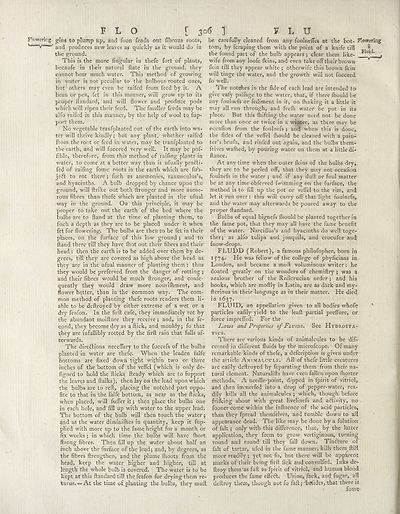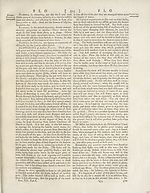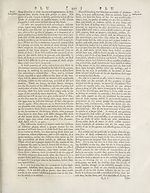Encyclopaedia Britannica > Volume 7, ETM-GOA
(332) Page 306
Download files
Complete book:
Individual page:
Thumbnail gallery: Grid view | List view

FLO [3°6] FLU
Flowering. £ms to plump up, and foon fends out fibrous roots, be carefully cleaned from any foulnefies at the bot- Flowering
and produces new leaves as quickly as it would do in
the ground.
This is the more Angular in thefe fort of plants,
becaufe in their natural ftate in the ground, they
cknnot bear much water. This method of growing
in water is not peculiar to the bulbous-rooted ones,
but others may even be raifed from feed by it. A
bean or pea, fet in this manner, will grow up to its
proper llandard, and will flower and produce pods
which will ripen their feed. The fmaller feeds may be
alfo raifed in this manner, by the help of wool to, fup-
port them.
No vegetable tranfplanted out of the earth into wa¬
ter will thrive kindly; but any plant, whether raifed
from the root or feed in water, may be tranfplanted to
the earth, and will fucceed very well. It may be pof-
fible, therefore, from this method of raifing plants in
water, to come at a better way than is ufually pra&i-
fed of raifing fome roots in the earth which are fub-
jeA to rot there ; fuch as anemonies, ranunculus’s,
and hyacinths. A bulb dropped by chance upon the
ground, will ftrike out both ftronger and more nume¬
rous fibres than thofe which are planted in the ufual
way in the ground. On this principle, it may be
proper to take out the earth of the bed where the
bulbs are to Hand at the time of planting them, to
fuch a depth as they are to be placed under it when
fet for flowering. The bulbs are then to be fet in their
places, on the furface of this low ground ; and to
Hand there till they have fhot out their fibres and their
head : then the earth is to be added over them by de¬
grees, till they are covered as high above the head as
they are in the ufual mariner of planting them : thus
they would be preferred from the danger of rotting ;
and their fibres would be much llronger, and' confe-
quently they would draw more nourifhment, and
flower better, than in the common way. The com¬
mon method of planting thefe roots renders them li¬
able to be deftroyed by either extreme of a wet or a
dry feafon. In the firft cafe, they immediately rot by
the abundant moifture they receive ; and, in the fe-
cpnd, they become dry as a flick, and mouldy; fo that
they are infallibly rotted by the firft rain that falls af¬
terwards.
The directions neceflary to the fuccefs of the bulbs
planted in water are thefe. When the leaden falfe
Bottoms are fixed down tight within two or three
inches of the bottom of the veflel (which is only de-
figned to hold the flicks fteady which are to fupport
the leaves and ftalks), then lay on the lead upon which
the bulbs are to reft, placing the notched part oppo-
fite to that in the falfe bottom, as near as the flicks,
when placed, will fuffer it; then place the bulbs one
in each hole, and fill up with water to the upper lead.
The bottom of the bulb will then touch the water;
and as the water diminifhes in quantity, keep it fup-
pKed with more up to the fame height for a month or
fix weeks; in which time the bulbs will have fhort
ftrong fibres. Then fill up the water about half an
inch above the furface of the lead; and, by degrees, as
the fibres ftrengthen, and the plume {hoots from the
head, keep the water higher and higher, till at
length the whole bulb is covered. The water is to be
kept at this ftandard till the feafon for drying them re¬
turns—At the time of planting the bulbs, they muft
tom, by fcraping them with the point of a knife till . •!,
the found part of the bulb appears ; clear them like- ut
wife from any loofe {kins, and even take off their brown
fl<in till they appear white ; otherwife this brown {kin
will tinge the water, and the growth will not fucceed
fo well.
The not«hes in the fide of each lead are intended to
give eafy paffage to the water, that, if there Ihould be
any foulnefs or fediment in it, on {baking it a little it
may all run through, and frelh water be put in its
place. But this fhifting the water need not be done
more than once or twice in a winter, as there may be
occafion from the foulnefs ; and when this is done*
the fides of the veffel (hould be cleaned with a pain¬
ter’s brufh, and rinfed out again, and the bulbs them-
felves waftied, by pouring water on them at a little di-
ftance.
At any time when the outer {kins of the bulbs dry,
they are to be peeled off, that they may not occafion
foulnefs in the water ; and if any dull or foul matter
be at any time obferved fwimming on the furface, the
method is to fill up the pot or veflel to the rim, and
let it run over: this will carry off that light foulnefs,
and the water may afterwards be poured away to the
proper ftandard.
Bulbs of equal bignefs Ihould be planted together in
the fame pot, that they may all have the fame benefit
of the water. Narciffus’s and hyacinths do well toge¬
ther; as .alfo tulips and jonquils, and crocufe? and
fnow-drops.
FLUDD (Robert), a famous philofopher, born in
1574. He was fellow of the college of phyficians in
London, and became a mo ft voluminous writer: he
doated greatly on the wonders of chemiftry ; was a
zealous brother of the Roiicrucian order ; and his
books, which are moftly in Latin, are as dark and my-
fterious in their language as in their matter. He died
in 1637.
FLUID, an appellation given to all bodies whofe *
particles eafily yield to the leaft partial preflure, or.
force impreffed. For the
Laws and Properties of Fluids. See Hydrosta¬
tics.
There are various kinds of animalcules to be dif-
cerned in different fluids by the microfcope. Of many
remarkable kinds of thefe, a defcription is given under
the article Animalcule. All of thefe little creatures
are eafily deftroyed by feparating them from their na¬
tural element. Naturalifts have even fallen upon ihorter
methods. A needle-point, dipped in fpirit of vitriol,
and then immerfed into a drop of pepper-water, rea¬
dily kills all the animalcules ; which, though before
friflcing about with great livelinefs and aftivity, no
fooner come within the influence of the acid particles,
than they fpread themfelves, and tumble down to all
appearance dead. The like may be done by a folution
of fait; only with this difference, that, by the latter
application, they feem to grow vertiginous, turning
round and round till they fall down. Tin&ure of
fait of tartar, ufed in the fame manner, kills them ftill
more readily; yet not fo, but there will be apparent
marks of their being firft lick and convulfed. Inks de-
ftroy them'as faft as fpirit of vitriol, and human blood
produces the fame effeft. Urine, fack, and fugar, all
dellroy them, though notfo faft; foslides, that there is
fome-
Flowering. £ms to plump up, and foon fends out fibrous roots, be carefully cleaned from any foulnefies at the bot- Flowering
and produces new leaves as quickly as it would do in
the ground.
This is the more Angular in thefe fort of plants,
becaufe in their natural ftate in the ground, they
cknnot bear much water. This method of growing
in water is not peculiar to the bulbous-rooted ones,
but others may even be raifed from feed by it. A
bean or pea, fet in this manner, will grow up to its
proper llandard, and will flower and produce pods
which will ripen their feed. The fmaller feeds may be
alfo raifed in this manner, by the help of wool to, fup-
port them.
No vegetable tranfplanted out of the earth into wa¬
ter will thrive kindly; but any plant, whether raifed
from the root or feed in water, may be tranfplanted to
the earth, and will fucceed very well. It may be pof-
fible, therefore, from this method of raifing plants in
water, to come at a better way than is ufually pra&i-
fed of raifing fome roots in the earth which are fub-
jeA to rot there ; fuch as anemonies, ranunculus’s,
and hyacinths. A bulb dropped by chance upon the
ground, will ftrike out both ftronger and more nume¬
rous fibres than thofe which are planted in the ufual
way in the ground. On this principle, it may be
proper to take out the earth of the bed where the
bulbs are to Hand at the time of planting them, to
fuch a depth as they are to be placed under it when
fet for flowering. The bulbs are then to be fet in their
places, on the furface of this low ground ; and to
Hand there till they have fhot out their fibres and their
head : then the earth is to be added over them by de¬
grees, till they are covered as high above the head as
they are in the ufual mariner of planting them : thus
they would be preferred from the danger of rotting ;
and their fibres would be much llronger, and' confe-
quently they would draw more nourifhment, and
flower better, than in the common way. The com¬
mon method of planting thefe roots renders them li¬
able to be deftroyed by either extreme of a wet or a
dry feafon. In the firft cafe, they immediately rot by
the abundant moifture they receive ; and, in the fe-
cpnd, they become dry as a flick, and mouldy; fo that
they are infallibly rotted by the firft rain that falls af¬
terwards.
The directions neceflary to the fuccefs of the bulbs
planted in water are thefe. When the leaden falfe
Bottoms are fixed down tight within two or three
inches of the bottom of the veflel (which is only de-
figned to hold the flicks fteady which are to fupport
the leaves and ftalks), then lay on the lead upon which
the bulbs are to reft, placing the notched part oppo-
fite to that in the falfe bottom, as near as the flicks,
when placed, will fuffer it; then place the bulbs one
in each hole, and fill up with water to the upper lead.
The bottom of the bulb will then touch the water;
and as the water diminifhes in quantity, keep it fup-
pKed with more up to the fame height for a month or
fix weeks; in which time the bulbs will have fhort
ftrong fibres. Then fill up the water about half an
inch above the furface of the lead; and, by degrees, as
the fibres ftrengthen, and the plume {hoots from the
head, keep the water higher and higher, till at
length the whole bulb is covered. The water is to be
kept at this ftandard till the feafon for drying them re¬
turns—At the time of planting the bulbs, they muft
tom, by fcraping them with the point of a knife till . •!,
the found part of the bulb appears ; clear them like- ut
wife from any loofe {kins, and even take off their brown
fl<in till they appear white ; otherwife this brown {kin
will tinge the water, and the growth will not fucceed
fo well.
The not«hes in the fide of each lead are intended to
give eafy paffage to the water, that, if there Ihould be
any foulnefs or fediment in it, on {baking it a little it
may all run through, and frelh water be put in its
place. But this fhifting the water need not be done
more than once or twice in a winter, as there may be
occafion from the foulnefs ; and when this is done*
the fides of the veffel (hould be cleaned with a pain¬
ter’s brufh, and rinfed out again, and the bulbs them-
felves waftied, by pouring water on them at a little di-
ftance.
At any time when the outer {kins of the bulbs dry,
they are to be peeled off, that they may not occafion
foulnefs in the water ; and if any dull or foul matter
be at any time obferved fwimming on the furface, the
method is to fill up the pot or veflel to the rim, and
let it run over: this will carry off that light foulnefs,
and the water may afterwards be poured away to the
proper ftandard.
Bulbs of equal bignefs Ihould be planted together in
the fame pot, that they may all have the fame benefit
of the water. Narciffus’s and hyacinths do well toge¬
ther; as .alfo tulips and jonquils, and crocufe? and
fnow-drops.
FLUDD (Robert), a famous philofopher, born in
1574. He was fellow of the college of phyficians in
London, and became a mo ft voluminous writer: he
doated greatly on the wonders of chemiftry ; was a
zealous brother of the Roiicrucian order ; and his
books, which are moftly in Latin, are as dark and my-
fterious in their language as in their matter. He died
in 1637.
FLUID, an appellation given to all bodies whofe *
particles eafily yield to the leaft partial preflure, or.
force impreffed. For the
Laws and Properties of Fluids. See Hydrosta¬
tics.
There are various kinds of animalcules to be dif-
cerned in different fluids by the microfcope. Of many
remarkable kinds of thefe, a defcription is given under
the article Animalcule. All of thefe little creatures
are eafily deftroyed by feparating them from their na¬
tural element. Naturalifts have even fallen upon ihorter
methods. A needle-point, dipped in fpirit of vitriol,
and then immerfed into a drop of pepper-water, rea¬
dily kills all the animalcules ; which, though before
friflcing about with great livelinefs and aftivity, no
fooner come within the influence of the acid particles,
than they fpread themfelves, and tumble down to all
appearance dead. The like may be done by a folution
of fait; only with this difference, that, by the latter
application, they feem to grow vertiginous, turning
round and round till they fall down. Tin&ure of
fait of tartar, ufed in the fame manner, kills them ftill
more readily; yet not fo, but there will be apparent
marks of their being firft lick and convulfed. Inks de-
ftroy them'as faft as fpirit of vitriol, and human blood
produces the fame effeft. Urine, fack, and fugar, all
dellroy them, though notfo faft; foslides, that there is
fome-
Set display mode to:
![]() Universal Viewer |
Universal Viewer | ![]() Mirador |
Large image | Transcription
Mirador |
Large image | Transcription
Images and transcriptions on this page, including medium image downloads, may be used under the Creative Commons Attribution 4.0 International Licence unless otherwise stated. ![]()
| Encyclopaedia Britannica > Encyclopaedia Britannica > Volume 7, ETM-GOA > (332) Page 306 |
|---|
| Permanent URL | https://digital.nls.uk/189125545 |
|---|
| Attribution and copyright: |
|
|---|
| Description | Ten editions of 'Encyclopaedia Britannica', issued from 1768-1903, in 231 volumes. Originally issued in 100 weekly parts (3 volumes) between 1768 and 1771 by publishers: Colin Macfarquhar and Andrew Bell (Edinburgh); editor: William Smellie: engraver: Andrew Bell. Expanded editions in the 19th century featured more volumes and contributions from leading experts in their fields. Managed and published in Edinburgh up to the 9th edition (25 volumes, from 1875-1889); the 10th edition (1902-1903) re-issued the 9th edition, with 11 supplementary volumes. |
|---|---|
| Additional NLS resources: |
|

